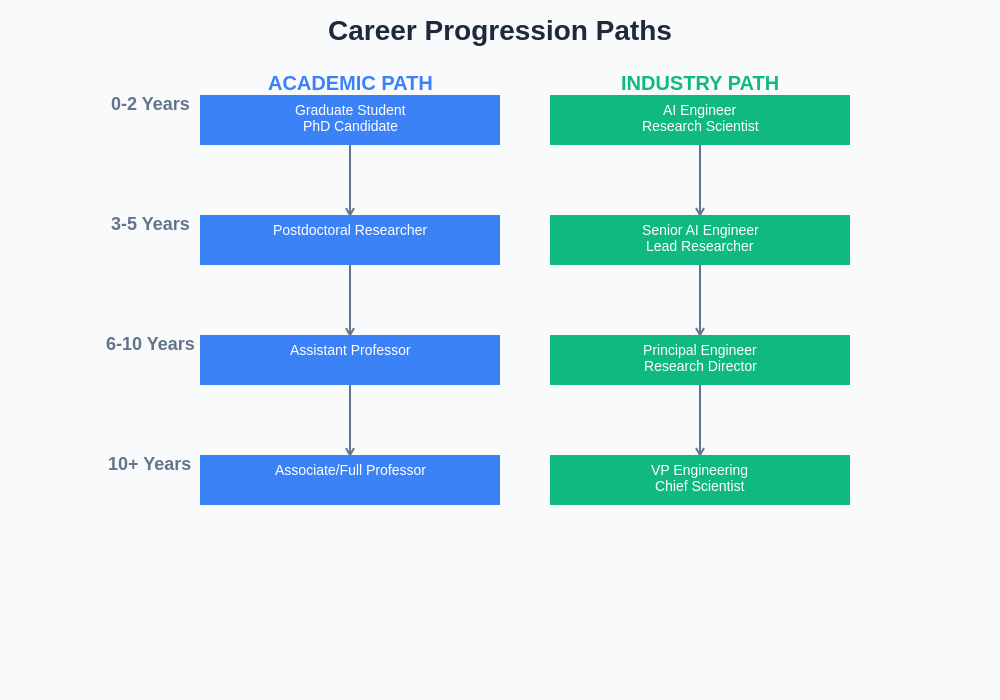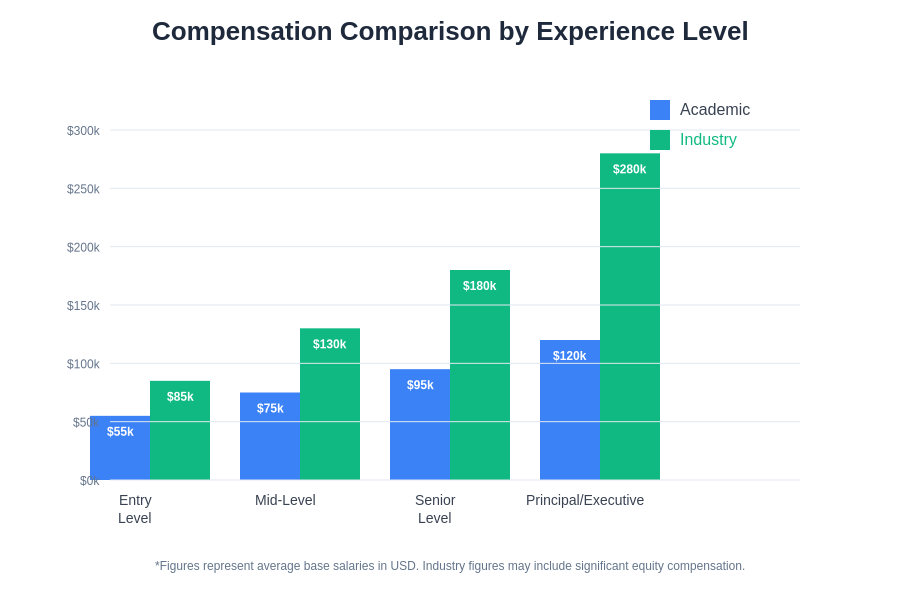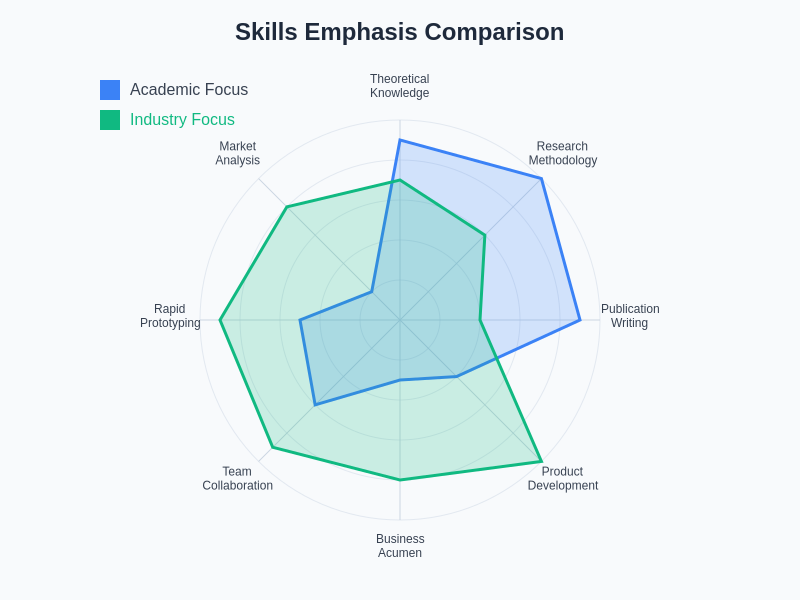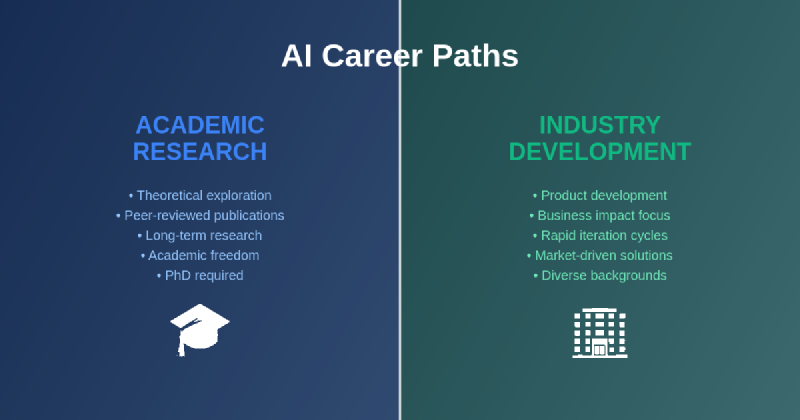The artificial intelligence revolution has created unprecedented career opportunities across two primary domains that often seem worlds apart yet increasingly interconnected. The choice between pursuing an academic research path or diving into industry product development represents one of the most significant decisions facing aspiring AI professionals today. This fundamental career crossroads shapes not only immediate opportunities but also long-term professional trajectories, research impact, and personal fulfillment in ways that extend far beyond traditional career considerations.
Explore the latest AI career trends and opportunities to understand how the landscape continues to evolve and create new pathways for ambitious professionals. The dynamic nature of AI development means that career boundaries are constantly shifting, creating hybrid opportunities that blur traditional distinctions between academic and industrial pursuits while opening entirely new professional paradigms.
The Academic Research Landscape
Academic AI research represents the foundational layer of artificial intelligence advancement, where theoretical breakthroughs emerge from deep intellectual exploration and methodical scientific inquiry. Universities, research institutions, and government laboratories serve as crucibles for fundamental discoveries that eventually revolutionize entire industries and reshape societal structures. The academic path typically begins with advanced graduate education, progressing through doctoral studies focused on specialized AI domains such as machine learning theory, computer vision, natural language processing, or robotics.
The academic environment fosters intellectual freedom that allows researchers to pursue long-term investigations without the immediate pressure of commercial viability or product deadlines. This freedom enables exploration of fundamental questions about intelligence, consciousness, and computational learning that may not yield immediate practical applications but contribute to the broader understanding of artificial intelligence systems. Academic researchers enjoy the privilege of following their curiosity wherever it leads, often making unexpected connections between disparate fields that result in breakthrough innovations.
Research universities provide access to cutting-edge computational resources, specialized laboratories, and collaborative networks that span global academic communities. The peer review process ensures rigorous validation of research findings while academic conferences and journals provide platforms for sharing discoveries with the broader scientific community. This environment cultivates deep expertise in specific domains while encouraging interdisciplinary collaboration that often produces the most significant advances in AI research.
The academic career progression follows a well-established trajectory from graduate student to postdoctoral researcher, assistant professor, associate professor, and eventually full professor. Each stage brings increased independence, research funding responsibilities, and opportunities to mentor the next generation of AI researchers. Tenure-track positions offer job security and intellectual freedom that few other careers can match, though competition for these positions has intensified as AI research has gained prominence and funding.
Industry Product Development Reality
Industry AI development operates in a fundamentally different ecosystem where theoretical research meets practical implementation challenges and market demands. Technology companies, startups, and established enterprises seek AI professionals who can translate cutting-edge research into scalable products that solve real-world problems and generate sustainable business value. The industry environment emphasizes rapid iteration, user-centered design, and measurable impact on business metrics and user experiences.
Enhance your AI development skills with advanced tools like Claude to stay competitive in the fast-paced industry environment where practical implementation skills are as valuable as theoretical knowledge. The industry rewards professionals who can bridge the gap between research insights and production-ready systems that operate reliably at scale while meeting strict performance and reliability requirements.
Product development teams work with compressed timelines and clear deliverables, requiring AI practitioners to make pragmatic decisions about model complexity, computational efficiency, and feature trade-offs. The industry values professionals who understand both the technical aspects of AI systems and the business context in which these systems operate. This dual competency enables AI engineers and researchers to design solutions that are not only technically sound but also commercially viable and strategically aligned with organizational objectives.
Industry positions often provide higher immediate compensation, stock options, and opportunities for rapid career advancement based on measurable contributions to product success and business growth. The collaborative nature of product development exposes AI professionals to diverse disciplines including user experience design, product management, software engineering, and business strategy, creating well-rounded skill sets that are highly valued across technology sectors.
The industry environment encourages experimentation with emerging technologies and frameworks while maintaining focus on practical outcomes and user impact. Companies invest heavily in infrastructure, data systems, and computational resources that enable AI practitioners to work with massive datasets and deploy models at unprecedented scale. This infrastructure access often surpasses what is available in academic settings, providing opportunities to explore AI applications that require industrial-scale resources.
Research Impact and Publication Priorities
Academic researchers measure success primarily through peer-reviewed publications, citation counts, research grants, and recognition within scientific communities. The publication process emphasizes rigorous methodology, reproducible results, and contributions to fundamental understanding of AI principles and capabilities. Academic papers undergo extensive peer review that validates research quality while providing constructive feedback from domain experts.
The academic reward system incentivizes groundbreaking research that advances the theoretical foundations of artificial intelligence, even if practical applications remain years or decades away. Researchers pursue questions that may seem esoteric to industry practitioners but ultimately provide the conceptual framework for future technological breakthroughs. The long-term nature of academic research allows for comprehensive exploration of complex problems that require sustained investigation over multiple years.

The divergent career trajectories in academic versus industry settings reflect fundamental differences in organizational structure, advancement criteria, and professional development opportunities. Academic progression follows a more structured timeline with clearly defined milestones, while industry advancement often depends on demonstrated impact and business value creation.
Research impact in academia extends beyond immediate practical applications to include educational contributions through teaching, mentoring, and curriculum development. Academic researchers play crucial roles in training the next generation of AI professionals who will populate both academic institutions and industry organizations. This educational impact multiplies the influence of individual researchers far beyond their direct research contributions.
Industry professionals measure impact through product performance metrics, user adoption rates, revenue generation, and business growth indicators. The industry values research that translates directly into improved user experiences, operational efficiencies, and competitive advantages. While industry researchers may publish findings in academic venues, the primary focus remains on developing intellectual property and maintaining competitive advantages through proprietary innovations.
Funding Models and Resource Allocation
Academic research relies heavily on government grants, private foundation funding, and institutional support that operates on multi-year cycles with specific research objectives and deliverables. Grant writing represents a significant component of academic careers, requiring researchers to articulate research vision, methodology, and expected outcomes in proposals that compete for limited funding resources. Successful grant acquisition depends on research track record, institutional reputation, and alignment with funding agency priorities.
Access comprehensive AI research resources through Perplexity to enhance grant writing and research proposal development with access to the latest funding opportunities and research trends. The competitive nature of academic funding requires researchers to demonstrate both intellectual rigor and practical relevance while maintaining focus on fundamental research questions.
Government agencies such as the National Science Foundation, Department of Defense, and National Institutes of Health provide substantial funding for AI research that aligns with national priorities and strategic interests. These funding sources enable large-scale collaborative projects that span multiple institutions and research domains, fostering the kind of comprehensive investigation that individual researchers or small teams cannot undertake independently.
Industry funding operates through corporate research budgets, venture capital investment, and revenue-driven resource allocation that responds rapidly to market opportunities and competitive pressures. Companies invest in AI research and development based on potential return on investment, strategic positioning, and immediate business needs. This funding model enables rapid scaling of successful initiatives while requiring clear justification for resource allocation based on measurable business impact.
Career Progression and Advancement Opportunities
Academic career advancement follows a structured pathway with clearly defined milestones and evaluation criteria based on research productivity, teaching effectiveness, and service contributions to the academic community. The tenure system provides job security for researchers who demonstrate sustained excellence in research and scholarship, though achieving tenure requires meeting increasingly demanding standards as competition intensifies.
Postdoctoral positions serve as crucial stepping stones between doctoral completion and independent research careers, providing opportunities to develop specialized expertise, build publication records, and establish collaborative relationships with established researchers. The postdoc experience often involves working on funded research projects while developing independent research programs that form the foundation for future academic positions.
Industry career progression offers multiple pathways including technical leadership roles, product management positions, and executive opportunities that extend beyond pure research and development responsibilities. Many technology companies provide dual-track career paths that allow technical professionals to advance without transitioning into management roles, maintaining focus on technical innovation while providing opportunities for increased compensation and responsibility.
The industry environment rewards rapid skill development and adaptability to emerging technologies, creating opportunities for accelerated career advancement based on demonstrated ability to deliver business value through AI implementations. Cross-functional collaboration exposes industry professionals to diverse career paths and provides networking opportunities that often lead to entrepreneurial ventures and leadership positions in emerging AI companies.
Compensation and Financial Considerations
Academic compensation typically includes base salary, research funding, sabbatical opportunities, and comprehensive benefits packages that emphasize long-term security over immediate financial rewards. Professor salaries vary significantly by institution type, geographic location, and research field, with top-tier research universities offering competitive packages that include research support and graduate student funding.
Research grants provide additional resources for equipment, travel, and personnel while sabbatical leaves offer opportunities for intensive research focus and international collaboration. The academic benefit structure often includes excellent health insurance, retirement contributions, and educational benefits for family members that provide substantial long-term value beyond immediate salary considerations.
Industry compensation generally exceeds academic salaries, particularly at technology companies competing for top AI talent in competitive markets. Base salaries are often supplemented by performance bonuses, stock options, and equity grants that can result in substantial wealth accumulation for professionals at successful companies. The potential for equity participation in startup ventures offers opportunities for extraordinary financial returns, though with corresponding risks.

The compensation differential between academic and industry positions becomes increasingly pronounced at senior levels, reflecting the different value propositions and market dynamics in each environment. While academic positions offer stability and intellectual freedom, industry roles provide higher earning potential and equity participation opportunities.
The industry compensation model rewards measurable contributions to product success and business growth, creating opportunities for rapid salary progression based on demonstrated impact. Many technology companies provide comprehensive benefits including health insurance, retirement matching, educational reimbursement, and professional development opportunities that support continued skill advancement and career growth.
Work-Life Balance and Professional Culture
Academic environments traditionally offer greater flexibility in work scheduling and location, allowing researchers to structure their time around research priorities, teaching responsibilities, and family obligations. The academic calendar includes extended breaks and sabbatical opportunities that provide time for intensive research focus, international collaboration, and personal rejuvenation that supports sustained productivity over long careers.
University settings foster intellectual communities where researchers engage in regular seminars, collaborative discussions, and interdisciplinary exchanges that stimulate creative thinking and innovative approaches to complex problems. The collegial atmosphere encourages open sharing of ideas and constructive criticism that advances collective understanding while supporting individual research development.
Industry environments often operate with more structured schedules and performance expectations, though many technology companies have adopted flexible work policies that accommodate diverse professional and personal needs. The collaborative nature of product development creates dynamic team environments where professionals work closely with colleagues from diverse backgrounds and expertise areas.
The fast-paced nature of industry development can create intense pressure during product launches and critical development phases, though successful companies recognize the importance of sustainable work practices that maintain long-term employee productivity and satisfaction. Many industry organizations invest heavily in employee well-being programs, professional development opportunities, and workplace culture initiatives that support career longevity and personal fulfillment.
Skills Development and Continuous Learning
Academic environments provide structured opportunities for deep skill development through coursework, research seminars, and conference participation that emphasize theoretical understanding and methodological rigor. Graduate programs offer comprehensive training in research methodology, statistical analysis, and domain-specific knowledge that provides strong foundations for both academic and industry careers.
The academic emphasis on peer review and publication requires development of critical thinking skills, scientific writing abilities, and presentation capabilities that serve professionals well across diverse career paths. Regular interaction with graduate students and postdoctoral researchers creates mentoring opportunities that enhance leadership skills while contributing to the academic community.
Industry positions require rapid adaptation to evolving technologies, frameworks, and business requirements that demand continuous learning and skill updating. Companies often provide training programs, conference attendance support, and educational reimbursement that enable professionals to stay current with emerging developments in AI technology and methodology.
The practical focus of industry development builds strong implementation skills, system design capabilities, and cross-functional collaboration abilities that are highly valued across technology sectors. Exposure to real-world constraints and user requirements develops problem-solving skills that complement theoretical knowledge with practical experience in deploying AI systems at scale.

The skills emphasis in academic versus industry environments creates distinctly different professional profiles, with academic careers prioritizing theoretical depth and research methodology while industry positions emphasize practical implementation and business impact. Understanding these skill differentials helps professionals align their development efforts with their chosen career path.
Collaboration and Networking Opportunities
Academic research thrives on collaboration across institutions, disciplines, and international boundaries that create rich professional networks spanning global research communities. Conference participation, workshop organization, and visiting researcher programs facilitate knowledge exchange and relationship building that often leads to lifelong professional partnerships and collaborative research initiatives.
The academic emphasis on knowledge sharing through publications, presentations, and open discussion creates communities of practice where researchers support each other’s work while advancing collective understanding of AI principles and applications. Interdisciplinary collaboration exposes researchers to diverse perspectives and methodologies that often inspire innovative approaches to complex problems.
Industry professionals participate in professional organizations, technology conferences, and open-source communities that facilitate knowledge sharing and professional development within the broader technology ecosystem. Company-sponsored research collaborations with academic institutions create hybrid opportunities that combine industry resources with academic freedom and rigor.
The entrepreneurial culture within many technology companies encourages networking and relationship building that often leads to new venture opportunities, career transitions, and collaborative projects that span organizational boundaries. Industry professionals often maintain connections with academic researchers through consulting relationships, advisory roles, and collaborative research projects.
Making the Strategic Career Decision
The choice between academic research and industry development paths depends on individual priorities, career objectives, and personal values that extend beyond immediate financial and professional considerations. Professionals who thrive in academic environments typically value intellectual freedom, long-term research impact, and the opportunity to contribute to fundamental understanding of AI principles and capabilities.
Those who find fulfillment in industry settings often prioritize practical impact, rapid feedback on their contributions, and the opportunity to see their work directly influence user experiences and business outcomes. The industry environment appeals to professionals who enjoy collaborative problem-solving, cross-functional teamwork, and the challenge of translating research insights into scalable products and services.
Many successful AI professionals find ways to participate in both environments through consulting relationships, adjunct teaching positions, research collaborations, and advisory roles that provide exposure to diverse perspectives and opportunities. The increasingly porous boundaries between academic and industry research create hybrid career paths that combine elements of both environments while maximizing individual strengths and interests.
The optimal career path often emerges through experimentation, networking, and honest self-assessment of personal motivations, working styles, and long-term professional objectives. Internships, visiting researcher positions, and collaborative projects provide valuable exposure to different environments while building the professional networks that often determine career opportunities and trajectory.
The future of AI careers lies not in choosing definitively between academic and industry paths but in developing the flexibility and adaptability to navigate increasingly interconnected professional ecosystems that reward diverse skills, perspectives, and contributions to the advancement of artificial intelligence technology and understanding.
Disclaimer
This article provides general information about AI career paths and should not be considered professional career advice. Individual experiences may vary significantly based on personal circumstances, institutional contexts, and market conditions. Readers should conduct thorough research and consider their specific goals and constraints when making career decisions. The AI field continues to evolve rapidly, and career opportunities and requirements may change substantially over time.
